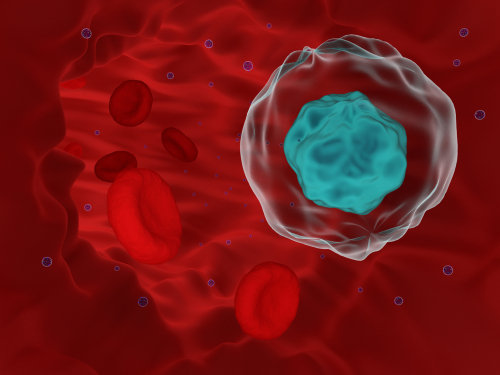Circulating tumor cell count could help choose treatment for metastatic breast cancer patients
San Antonio Breast Cancer Symposium 2018 Press Release Dec 08, 2018
Circulating tumor-cell (CTC) count could be used to choose hormone therapy or chemotherapy as frontline treatment for patients with estrogen receptor-positive (ER+), HER2-negative (HER2-) metastatic breast cancer, according to data from the phase III STIC CTC clinical trial presented at the 2018 San Antonio Breast Cancer Symposium, held Dec. 4–8.

In the case of discrepancy between CTC count-based treatment choice and physician’s choice of treatment, frontline chemotherapy was associated with a significant gain in overall survival. “Two main treatment options exist for patients newly diagnosed with metastatic, ER+, HER2- breast cancer: hormone therapy or chemotherapy (eventually followed by maintenance hormone therapy).
There is unfortunately no validated predictive biomarker to guide that choice,” said Francois-Clement Bidard, MD, PhD, Professor of Medical Oncology at Institut Curie (Saint Cloud, France) and University of Versailles. While frontline hormone therapy is the preferred treatment option because of limited side effects, chemotherapy is proposed in patients presenting with adverse prognostic factors, Bidard explained.
These factors are, however, not well defined in the current literature and, as the choice between hormone therapy and chemotherapy relies on the doctor’s estimate of the patient prognosis, different doctors may, in turn, propose different treatments to the same patient, he noted. “CTC count has been investigated in thousands of breast cancer patients worldwide over the past decade, and numerous analyses have established that, beyond performance status, CTC count is the strongest prognostic marker in ER+, HER2- stage 4 breast cancer patients,” Bidard said.
His team studied whether CTC count can be used to assess a patient’s prognosis and personalize the choice between hormone therapy and chemotherapy. “In our study, not only have we demonstrated that basing the decision on CTC count alone does not harm patients in the overall study population (primary objective), but subgroup analyses show that, in the 292 patients with discordant treatment recommendations (between the clinician estimate and the CTC count), frontline chemotherapy was associated with a significant 35 percent decrease in the risk of death,” Bidard said.
In this trial, 778 patients were randomly assigned 1:1 to a clinically driven treatment arm (hormone therapy or chemotherapy was administered as decided by a physician based on clinical factors) or a CTC-driven treatment arm (hormone therapy was administered if 7.5 ml blood had less than 5 CTC and chemotherapy was administered if 7.5 ml blood had 5 or more CTC).
After randomization, in the clinically driven arm, 72.6 percent of the patients received hormone therapy and 27.4 percent received chemotherapy. In the CTC-driven arm: • Among those likely to receive hormone therapy by clinically driven choice, this treatment option was confirmed by a low CTC count in 66.7 percent of the patients; the remaining 33.3 percent were switched to chemotherapy based on a high CTC count;
Among those likely to receive chemotherapy by clinically driven choice, this treatment option was confirmed by high CTC count in 48.1 percent of the patients; the remaining 52.9 percent were switched to hormone therapy based on low CTC count.
The study met its primary endpoint (assessed in the 778 patients), with progression-free survival (PFS) not being inferior in the CTC-driven arm, compared with the clinically driven arm. Patients whose treatment was escalated to chemotherapy based on CTC count had a significantly longer PFS (median PFS was 10.5 months with hormone therapy in the clinically driven arm who had high CTC count, versus 15.5 months with chemotherapy in the CTC arm) and showed a trend toward longer overall survival (OS, 37.1 vs. 42.0 months).
In contrast, patients whose treatment was de-escalated to hormone therapy based on CTC count had non-significantly shorter PFS and OS compared with those who received chemotherapy in the clinically driven arm who had low CTC count.
In an exploratory analysis, pooling the two subgroups of patients (292) with discordant treatment recommendations showed that patients treated with frontline chemotherapy had significantly longer PFS (34 percent less likely to have their disease progress) and OS (35 percent lower risk of death).
Overall survival rates at 24 months were 82.9 percent in patients treated with chemotherapy (eventually followed by maintenance hormone therapy) vs. 74.7 percent in patients treated with frontline hormone therapy. “Since the 90’s, no trial has assessed the question of front-line therapy, and our results suggest that modern prognostic biomarkers, such as the CTC count, may lead to better patient survival,” Bidard added.
Bidard noted that a main limitation of the study is that during the STIC CTC study follow-up, CDK4/6 inhibitors (palbociclib, ribociclib, and abemaciclib) became largely used as first-line treatment, therefore, doctors are more likely to recommend front-line hormone therapy combined with CDK4/6 inhibitors rather than chemotherapy.
This study was funded by the French Ministry of Health, Menarini Silicon Biosystems, and Institut Curie. Bidard’s disclosures related to this study: Menarini Silicon Biosystems (research funding, travel grant); Unrelated to this study: Amgen (lecture fees, travel grant), Astra-Zeneca (consulting fees, lecture fees), Lilly (consulting fees), Novartis (research grant), Pfizer (lecture fees, consulting fees, travel grant), Roche (consulting fees, travel grant), Sanofi (consulting fees, travel grant).
This article is a press release of a study presented at the 2018 San Antonio Breast Cancer Symposium. Read the original here.
-
Exclusive Write-ups & Webinars by KOLs
-
Daily Quiz by specialty
-
Paid Market Research Surveys
-
Case discussions, News & Journals' summaries